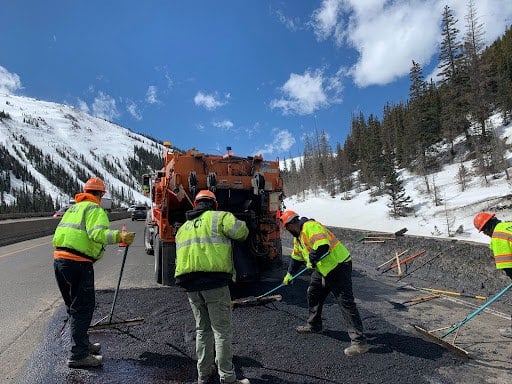CDOT addressing potholes on state highways as harsh winter conditions subside
Travel Advisory
Colorado – The Colorado Department of Transportation is advising drivers to be prepared for temporary lane closures on the state highway system as maintenance crews repair potholes that develop due to the springtime freeze-thaw cycle.
Above-normal amounts of snow and below-average winter temperatures created additional potholes in many areas of the state, including on the Western Slope and southwestern Colorado. Although crews were able to make temporary repairs during the cold weather months, materials for permanent repairs require consistently warm temperatures.
For the next several weeks, drivers should be prepared for moving, single lane closures, along with possible delays, while potholes are being repaired. CDOT is urging motorists to slow down when approaching these work zones for the safety of everyone involved, especially crew members working to repair the pavement. While lane closures are generally limited to night-time hours in some areas of the state, pothole repairs may occur during the day to prevent further deterioration and damage to the roadway.
“In addition to the cold temperatures, Colorado had abnormally high amounts of snow and ice this past winter season,” said CDOT Executive Director Shoshana Lew. “Now with the warmer temperatures, we’re out in full force to make the repairs necessitated by this winter’s conditions in order to keep our highways safe and reliable for the traveling public. Our maintenance team plays a key role in making critical repairs like fixing potholes, so please respect work zones and help keep them safe on the job."
CDOT recommends that if you cannot avoid a pothole, please reduce your speed and check your rear or side-view mirrors before swerving or braking abruptly. Hitting a pothole at higher speeds greatly increases the chance of damaging tires, wheels and suspension components. Also, puddles require extra caution since they can disguise a deep hole.
Drivers who see or hit a pothole on a state highway should report it to a CDOT customer service representative so repairs can be scheduled. CDOT only maintains state roadways. Cities and counties are generally responsible for potholes on non-state roadways and should be directed to the proper jurisdiction.
To report a pothole, please call one of the following CDOT Customer Service Hotline Numbers:
- Metropolitan Denver – Region 1: 303-759-2368
- Southeastern Colorado – Region 2: 719-562-5568
- Northwestern Colorado – Region 3: 970-243-2368
- Northeastern Colorado – Region 4: 970-350-2368
- Southwestern Colorado – Region 5: 970-385-1423
Potholes are caused by the expansion and contraction of ground water under the pavement. When the water freezes, it fills more space under the pavement, which then expands, bends and cracks, weakening the road surface. When the ice melts, the pavement contracts, leaving gaps or voids underneath the surface. This continuous freeze–thaw cycle weakens the pavement and allows it to continue cracking. As the weight of vehicles pass over the weakened pavement, it causes it to break and creates a pothole.
General Pothole Information
- Average cost: $60 per square yard, depending on hole depth and width
- Crew size: Operational safety requires three people minimum (two actively repairing pothole, one managing attenuator truck behind crew. An attenuator truck is designed to meet all work zone safety requirements by absorbing the impact of a high (or low) speed crash and, in turn, saving workers’ lives.
- Repair time: Varies between 10 and 30 minutes, depending on hole depth and width.
- Traffic impacts: Full-lane closure required, per CDOT protocol, on any travel lane requiring the stopping or exiting of vehicles.

Know Before You Go
Travelers are urged to “know before you go.” Gather information about weather forecasts and anticipated travel impacts and current road conditions prior to hitting the road. CDOT resources include:
- Road conditions and travel information: COtrip.org
- Download the COtrip Planner app: bit.ly/COtripapp
- Sign up for project or travel alerts: bit.ly/COnewsalerts
- See scheduled construction lane closures: bit.ly/laneclosures
- Connect with @ColoradoDOT on social media: Twitter, Facebook, Instagram and YouTube
Remember: Slow For The Cone Zone
The following tips are to help you stay safe while traveling through maintenance and construction work zones.
- Do not speed in work zones. Obey the posted speed limits.
- Stay Alert! Expect the unexpected.
- Watch for workers. Drive with caution.
- Don't change lanes unnecessarily.
- Avoid using mobile devices such as phones while driving in work zones.
- Turn on headlights so that workers and other drivers can see you.
- Be especially alert at night while driving in work zones.
- Expect delays, especially during peak travel times.
- Allow ample space between you and the car in front of you.
- Anticipate lane shifts and merge when directed to do so.
- Be patient!
Download the COtrip App!
The new FREE COtrip Planner mobile app was designed to meet the growing trend of information on mobile and tablet devices for the traveling public. The COtrip Planner app provides statewide, real-time traffic information, and works on mobile devices that operate on the iOS and Android platforms. Visit the Google Play Store (Android devices) or the Apple Store (iOS devices) to download!
